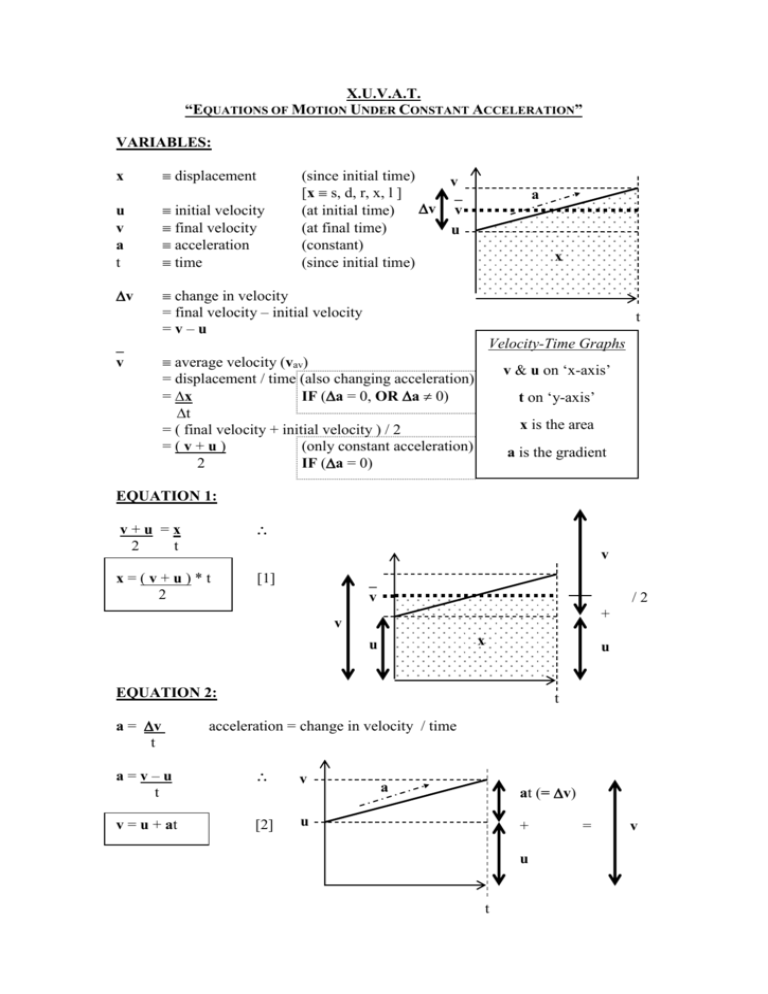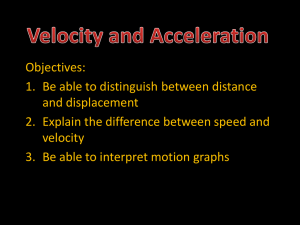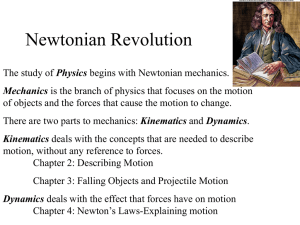SUVAT equations of motion under constant acceleration
advertisement

X.U.V.A.T. “EQUATIONS OF MOTION UNDER CONSTANT ACCELERATION” VARIABLES: x displacement u v a t initial velocity final velocity acceleration time v change in velocity = final velocity – initial velocity =v–u _ v (since initial time) v [x s, d, r, x, l ] _ v v (at initial time) (at final time) u (constant) (since initial time) a x t Velocity-Time Graphs average velocity (vav) = displacement / time (also changing acceleration) = x IF (a = 0, OR a 0) t = ( final velocity + initial velocity ) / 2 =(v+u) (only constant acceleration) 2 IF (a = 0) v & u on ‘x-axis’ t on ‘y-axis’ x is the area a is the gradient EQUATION 1: v+u =x 2 t x=(v+u)*t 2 [1] v _ v /2 + v x u u EQUATION 2: a = v t t acceleration = change in velocity / time a=v–u t v v = u + at [2] u a at (= v) + u t = v EQUATION 3: Substituting equation 2 into equation 1: x=(v+u)*t 2 v = u + at v a at [1] u [2] x u x = ((u + at) + u ) * t 2 t = (2u + at) * t 2 = (2u*t + at*t) 2 x = ut + ½at2 at (at * t)/2 u*t u [3] t EQUATION 4: Rearrange Equation 2 and substitute for t in Equation 1: v = u + at [2] t= v–u a x=(v+u)*t 2 v a u [1] x x= v+u * v–u 2 a u = (v+u)*(v–u) 2a = v*(v–u)+u*(v–u) 2a = v2 – uv + uv – u2 2a = v2 – u2 2a v2 = u2 + 2ax [4] v t v v u xa v2 – u2 = xa 2 SUMMARY OF THE X.U.V.A.T. EQUATIONS: x=(v+u)*t 2 v = u + at [1] When acceleration is not needed. [a] [2] When displacement is not needed. [x] x = ut + ½at2 [3] When final velocity is not needed. [v] v2 = u2 + 2ax [4] When time is not needed. [t] NB: Each formula relates four of the five kinematic (XUVAT) quantities for constant acceleration situations. PROBLEM SOLVING WITH X.U.V.A.T. EQUATIONS: STEP 1: Read the problem carefully! Write down the quantities that are known and the quantities that are unknown, which are required for the solution. STEP 2: Draw a diagram that shows the relationship between the required quantities. STEP 3: Check to see that at least three of the five X.U.V.A.T. quantities are known: a) If not find a way to calculate a third X.U.V.A.T. quantity (i.e., remember basic formulae such as “vav = x / t”, other mathematical (especially geometric from a diagram) equations, or word clues. b) If you have three X.U.V.A.T. quantities and need to find two others then repeat the next two steps for each unknown quantity. STEP 4: Select an appropriate equation (i.e., one that includes the required quantities). STEP 5: If necessary, rearrange the equation so that the unknown is expressed in terms of the knowns (i.e., so the unknown is alone on one side of the equation). STEP 6: Check that the quantities are expressed as values with comparable units (i.e., metres, kilometres, seconds, minutes, or hours). Substitute the variables in the equation with the known values and calculate the unknown quantity. Be sure to include the units, direction, and significant digits. Remember: Graph Type Displacement-Time Velocity-Time Acceleration-Time Gradient (change over time) Velocity Acceleration - Area (sum over time) Displacement Velocity SOME X.U.V.A.T. PROBLEMS: 1. A stone is dropped into a well and takes 3.0 s to splash into the water. During the drop the stone accelerates toward the water a constant 10 ms-2. a) What is the stone’s velocity when it splashes into the water? b) How far has the stone travelled between the drop and the splash? 2. The driver of a travelling car braked to stop at the traffic lights. The skid marks on the road were 12 m long and the braking lasted 2.0 s. a) How fast was the car travelling when the brakes were first applied? b) What was the acceleration of the car during breaking? 3. The graph below shows the velocity of a skateboarder travelling on a straight path. Skateboarder's Motion 1.5 Velocity (m/s) 1.0 0.5 0.0 -0.5 0 10 20 30 40 50 60 70 80 -1.0 -1.5 Time (s) a) During which time period(s) was the acceleration of the skateboarder zero? b) What was the displacement of the skateboarder at the end of the 80 s period? c) At what point in time did the skateboarder change direction? d) At what point in time did the skateboarder return to the starting point? e) During what time period did the skateboarder have a negative acceleration? f) During what time period did the skateboarder decrease their speed? g) What is the acceleration of the skateboarder between 50 s and 60 s? h) Describe the skateboarder’s motion in words. i) What was the average velocity across the entire 80 s period? * j) What is the average acceleration of the skateboarder for the first 20 s? * 90









